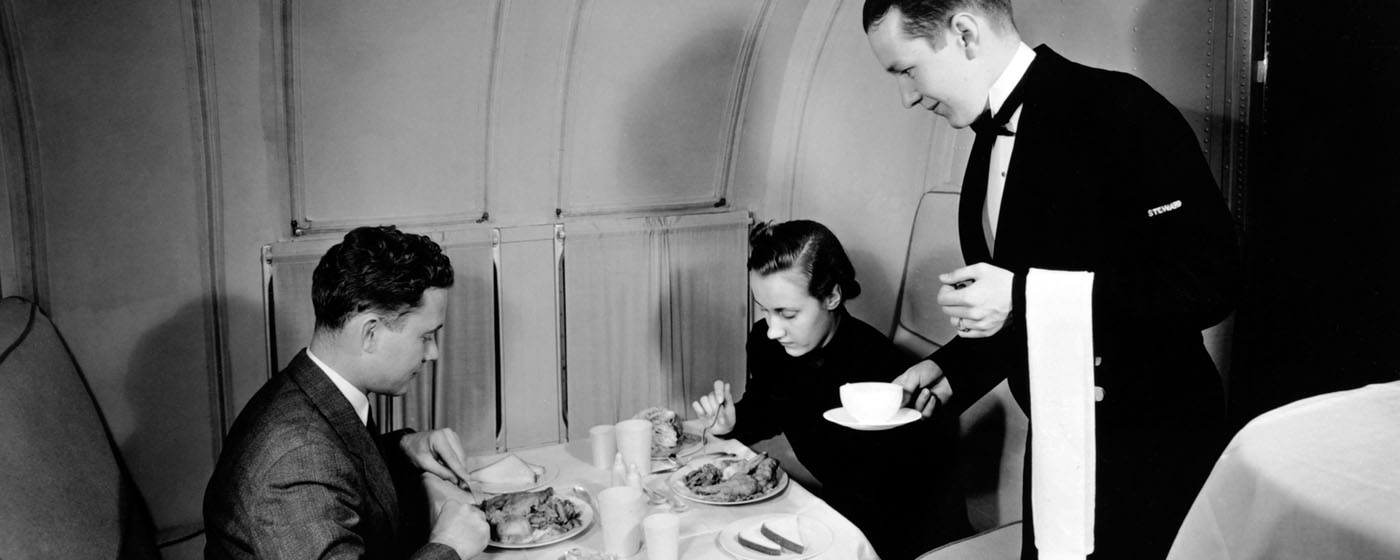In-flight catering
The transportation boom in the 20th century paved the way for a new way of eating: in-flight catering. In the skies, the concept experienced a little turbulence before finally taking off. There was a lack of space, weight was limited and, before the invention of the pressurised cabin, consuming bottled drinks was a dangerous business! In one generation, airline food went from being a cold, frugal meal eaten from a tray on your knees, to a gourmet ‘journey’ in the 1960s.
From a tray on your knees to a gourmet meal: the history of in-flight catering
With the expansion of public transport, companies realised that they needed to offer their passengers much more than just a journey from one place to another. On-board catering was initially the privilege of the wealthy social classes who could afford to travel in the new modes of transport.
Ocean liners were the first to offer on-board catering and became a model for the railways, which began to offer this service in 1838 on the line between Philadelphia and Baltimore in the United States. Then, in 1867, George Pullman introduced sleeper cars on the Great Western railway line in Canada. In these veritable hotels on rails, freshly prepared meals were served at table. Unlike its counterparts on sea and land, in-flight catering during air travel ran into quite some turbulence before finally taking off.
The first airlines emerged shortly after the First World War and were mainly used for transporting mail. Then passengers climbed on board and were seen as another type of commodity to be transported. On planes, the on-board ‘meals’ were basic and were only intended for the crew. There was a lack of space, weight was limited and, before the invention of the pressurised cabin, consuming bottled drinks proved to be a dangerous business! The development of the aeronautical industry, combined with advances in the food industry, revolutionised airline food. In the 1930s, passenger transport developed on a massive scale and on-board catering became a necessity. In the United States, United American had fully fitted kitchens built in the airports they served, while Pan American served meals prepared by renowned restaurants and hotels located nearby. The meals were kept warm in isothermal boxes until it was time to serve them. Drinks in aluminium cans soon replaced bottles, because they were lighter and could withstand changes in pressure. People still ate with a tray on their knees until individual drop-down trays were installed.
In the 1950s, the introduction of jet planes and the invention of convection ovens revolutionised the way meals could be kept and served. Capacity increased, both in terms of passenger numbers and the amount of space dedicated to food storage. Flight times became shorter and service became quicker and more efficient. The golden age of airline catering took off in the 1960s. The brand new Boeing 707 introduced 1st class passengers to haute cuisine and flying was no longer just a mode of transport but quite the gastronomic experience. Pan American, for example, entered into a partnership with Maxim’s in Paris, one of the French capital’s most renowned restaurants. Trans World Airlines developed its own Royal Ambassador Service for transoceanic flights. Its menu featured champagne, cocktails and caviar as a starter, followed by a main course of meat and fish (beef steak, filet mignon, roast lamb, coq au vin, sole fillets) cooked according to the diner’s choice, seasonal fruit and vegetables, and a basket of warm bread rolls. Passengers were served individually, with roast and cured meats carved in front of them.
Roast chicken and cat in a balloon: a meal in the air
One of the first meals eaten in the air took place in 1785 above English soil. Vincenzo Lunardi, an aeronautical adventurer, brought a roast chicken, cheese, salads and wine with him on his hot air balloon, along with a cat as a flight companion. Unfortunately, the sand used to ballast the balloon scattered all over his picnic, but he managed to save a chicken drumstick and the wine. He gave the rest to the cat before throwing the cutlery, bottle and food overboard without worrying about where the rubbish would land.
FOSS, Richard, 2015. Food in the Air and Space. The Surprising History of Food and Drink in the Skies. New York, London : Rowman & Littlefield. 978-1-4422-2728-6.
MCCOOL, Audrey C., 1995. Inflight Catering Management. New York : John Wiley & Sons.
MCKENZIE, William A., 1990. Dining Car Line to the Pacific. St. Paul : Minnesota Historical Society Press.
MENCKEN, August. 2000. The Railroad Passenger Car. Baltimore : Johns Hopkins Press.




